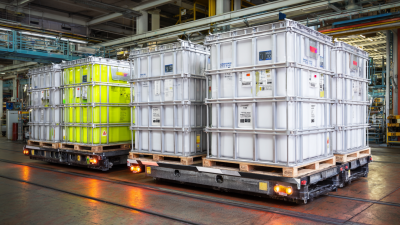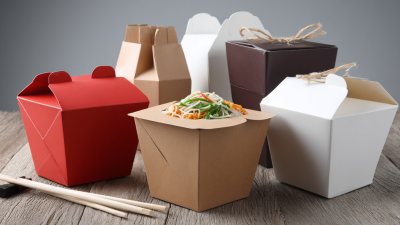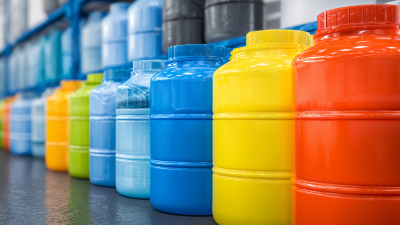
Blog
Ultimate Guide to Sourcing Bulk Containers for Your Business Needs
In the ever-evolving landscape of global commerce, the efficient management of logistics has become paramount for businesses aiming to maximize profitability and streamline operations. One critical component of this supply chain optimization is the use of bulk containers, which, according to recent industry reports, account for approximately 80% of global trade by value. As companies increasingly shift towards sustainable practices and cost-effective solutions, sourcing the right bulk containers has emerged as a key strategy in reducing waste and enhancing shipping efficacy. With the bulk container market projected to grow at a CAGR of 4.5% from 2021 to 2026, understanding the various comparison types available is essential for businesses to stay competitive and meet their logistical demands. This ultimate guide will delve into the nuances of sourcing bulk containers tailored to your specific needs, ensuring you make informed decisions that align with industry standards and trends.

Understanding the Different Types of Bulk Containers Available for Businesses
When it comes to sourcing bulk containers for your business, understanding the different types available is crucial. Various industries rely on bulk containers ranging from food and beverage to chemicals and pharmaceuticals. According to a recent report by Grand View Research, the global bulk container market is projected to reach USD 47.24 billion by 2025, highlighting its significance in supply chain logistics. Each type of container serves unique operational needs, making it essential for businesses to choose wisely.
For instance, intermediate bulk containers (IBCs) are ideal for storing and transporting liquids and bulk materials, offering a capacity of 275 to 330 gallons. These containers are not only space-efficient but also reusable, making them a sustainable option. Moreover, flexible bulk containers (FIBCs) are widely used in industries handling dry bulk products, capable of holding between 500 to 2,000 kilograms. As companies increasingly prioritize environmental sustainability, the Shift Towards Reusable Containers report by the Container Recycling Institute emphasizes the importance of selecting containers designed for longevity and recyclability, aligning operational needs with eco-friendly practices.
Ultimate Guide to Sourcing Bulk Containers for Your Business Needs
| Container Type | Capacity (Liters) | Material | Ideal Use Case | Average Cost ($) |
|---|---|---|---|---|
| IBC Tote | 1000 | HDPE (High-Density Polyethylene) | Liquids, Chemicals | 150 |
| Drum | 200 | Steel, Plastic | Oils, Liquids | 75 |
| Bulk Bin | 500 | Food Grade Plastic | Dry Goods, Food Products | 120 |
| Container Box | 800 | Cardboard, Plastic | Secondary Packaging | 50 |
| Flexitank | 24000 | Flexible Plastic | Liquids in Bulk | 300 |
Key Factors to Consider When Sourcing Bulk Containers
When sourcing bulk containers for business needs, several key factors must be considered to ensure efficiency and cost-effectiveness. According to a report by Grand View Research, the global bulk container market was valued at approximately $12.4 billion in 2021 and is expected to grow at a CAGR of 4.8% through 2028. This underscores the importance of making informed choices to stay competitive in a rapidly expanding market.
First, businesses should evaluate the type of material that best suits their products. For instance, different materials such as plastic, metal, or composite can significantly affect durability and preservation. Data from the Flexible Packaging Association suggests that flexible bulk containers, made from high-quality plastics, have a lower failure rate and provide better moisture protection compared to traditional rigid containers. Additionally, companies should assess the transportation and storage requirements of these containers, as logistics can impact overall operational costs.
Lastly, compliance with industry regulations is crucial when sourcing bulk containers. A report by MarketsandMarkets indicates that over 25% of companies experience compliance-related delays due to improper container specifications. Ensuring that containers meet safety and environmental standards not only mitigates risks but also enhances brand reputation. By focusing on these critical factors, businesses can optimize their sourcing strategies and leverage bulk containers to drive productivity and profitability.

Comparative Analysis of Materials Used in Bulk Container Manufacturing
When it comes to sourcing bulk containers for your business, understanding the materials used in their manufacturing is crucial. Two of the most prevalent materials are plastic and metal, each offering distinct benefits and drawbacks.
Plastic containers are lightweight, resistant to corrosion, and often more affordable than their metal counterparts. They cater well to various industries, including food and pharmaceuticals, due to their adaptability and ease of cleaning. However, concerns regarding environmental sustainability and durability in extreme conditions can limit their long-term applicability.
On the other hand, metal containers, such as those made from stainless steel or aluminum, provide enhanced strength and resistance to wear and tear. These materials excel in industries where durability is paramount, such as chemicals and hazardous materials. While they tend to be more expensive and heavier, their longevity and recyclability often justify the higher cost. Additionally, metal containers typically have better thermal resistance, making them ideal for temperature-sensitive products. Evaluating these materials’ properties plays a significant role in determining the most suitable bulk container for your business needs.
Best Practices for Maintaining and Storing Bulk Containers
When it comes to maintaining and storing bulk containers, implementing best practices is crucial for ensuring product integrity and maximizing efficiency.
First and foremost, cleanliness should be a priority. Regular cleaning of containers not only prevents contamination but also prolongs their lifespan. Using appropriate cleaning agents specific to the type of material stored within the containers is essential. For instance, food-grade containers require non-toxic, biodegradable cleaning solutions, while industrial containers may need stronger detergents suited for their contents.
Additionally, proper storage techniques can significantly impact the condition of bulk containers. Containers should be stored in a cool, dry place away from direct sunlight and extreme temperatures to prevent degradation.
Organizing containers in a systematic manner allows for easier access and inventory management, minimizing the risk of damage caused by improper handling. Furthermore, implementing a first-in, first-out (FIFO) approach for inventory will ensure that older stock is used before newer supplies, maintaining freshness and compliance with safety standards. By adhering to these best practices, businesses can enhance operational efficiency and safeguard their products.

Cost-Effective Strategies for Purchasing Bulk Containers in Large Quantities
In today's market, sourcing bulk containers efficiently can significantly impact your business's bottom line. As costs continue to rise, especially in the grocery sector, purchasing in bulk emerges as a cost-effective strategy that can lead to substantial savings. With food prices on an upward trend, the potential for bulk buying to mitigate these increases becomes increasingly attractive. By investing in Intermediate Bulk Containers (IBC), businesses not only benefit from lower per-unit costs but also enhance their storage efficiency, creating a more streamlined operation.
Moreover, as companies increasingly prioritize sustainability, bulk purchasing aligns with eco-friendly practices. Reusable packaging systems are gaining traction as a means to reduce waste and conserve natural resources. This shift indicates that sourcing bulk containers can also be a strategic move towards greener business practices, appealing to environmentally conscious consumers. The growth of the bulk container market reflects a broader trend; companies that adapt to these purchasing strategies are likely to thrive in an ever-evolving marketplace.
Bulk Container Sourcing Cost Analysis
This chart illustrates the average pricing of various types of bulk containers sourced for business needs. The data represents cost in USD for different container types when purchased in large quantities.
Related Posts
-

Innovative Solutions for Maximizing Efficiency with Best Plastic Bulk Containers
-

7 Compelling Reasons to Choose the Best Take Out Boxes for Your Business
-

The Future of Ecofriendly Take Out Food Containers
-

China's Commitment to Quality: The Rise of Best Plastic Gallon Containers on the Global Market
-

Top Strategies for Choosing the Best Plastic Packaging Solutions
-

Exploring the Best Options for Bulk Plastic Bottles A Comprehensive Comparison Guide
